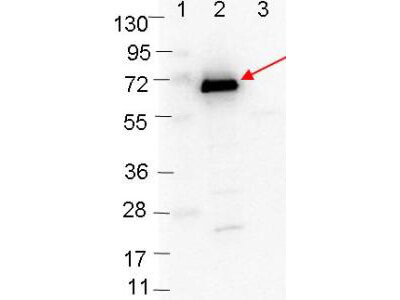Anti-OspC (RABBIT) Antibody
OspC Antibody
- SPECIFICATION
- CITATIONS
- PROTOCOLS
- BACKGROUND
| Host | Rabbit |
|---|---|
| Conjugate | Unconjugated |
| Target Species | Borrelia burgdorferi |
| Clonality | Polyclonal |
Application
| WB, I, LCI |
| Application Note | This protein-A purified antibody has been tested for use in Western blotting and in ELISA. Specific conditions for reactivity should be optimized by the user. Expect a band approximately 20.7 kDa in size corresponding to Borrelia burgdorferi OspC protein by Western blotting in the appropriate cell lysate or extract. |
| Physical State | Lyophilized |
| Buffer | 0.02 M Potassium Phosphate, 0.15 M Sodium Chloride, pH 7.2 |
| Immunogen | MBP-fusion protein corresponding to Borrelia burgdorferi OspC protein. |
| Reconstitution Volume | 100 µL |
| Reconstitution Buffer | Restore with deionized water (or equivalent) |
| Preservative | 0.01% (w/v) Sodium Azide |
| Other Names | 1194415 |
|---|---|
| Purity | This product was Protein-A purified and cross-adsorbed against MBP from monospecific antiserum by chromatography. This antibody is specific for Borrelia burgdorferi OspC protein. A BLAST analysis was used to suggest cross-reactivity with p39 from B. burgdorferi, afzelii, and valaisiana sources based on 100% homology with the immunizing sequence. Partial reactivity is expected against B. japonica and americana sources based on 94% homology. Cross-reactivity with OspC from other sources has not been determined. |
| Storage Condition | Store vial at 4° C prior to restoration. For extended storage aliquot contents and freeze at -20° C or below. Avoid cycles of freezing and thawing. Centrifuge product if not completely clear after standing at room temperature. This product is stable for several weeks at 4° C as an undiluted liquid. Dilute only prior to immediate use. |
| Precautions Note | This product is for research use only and is not intended for therapeutic or diagnostic applications. |
| Name | ospC {ECO:0000303|PubMed:8478108} |
|---|---|
| Function | A major immunodominant protein in mammalian hosts (PubMed:8098841, PubMed:8225587, PubMed:8478109). Required for the initial stages of mammalian infection (PubMed:14970347, PubMed:16714588, PubMed:20199597, PubMed:28873507). Interaction with tick I.ricinus salivary protein Salp15 protects the bacteria from antibody-mediated killing in vitro and in vivo (PubMed:18752445). Inhibits macrophage-mediated phagocytosis of the bacteria (PubMed:26438793). Binds human plasminogen; this probably confers an extracellular protease activity on the bacteria that allows it to traverse tissue (PubMed:20199597, PubMed:22433849). Binds human complement C4-B, which may inhibit the complement cascade (Probable) (PubMed:28873507). Experiments in mice suggest it may play another role after initial infection (Probable) (PubMed:27611840). |
| Cellular Location | Cell outer membrane; Lipid-anchor. Cell surface Note=Expressed in a punctate fashion on a subset of cells in vitro |

Thousands of laboratories across the world have published research that depended on the performance of antibodies from Abcepta to advance their research. Check out links to articles that cite our products in major peer-reviewed journals, organized by research category.
info@abcepta.com, and receive a free "I Love Antibodies" mug.
Provided below are standard protocols that you may find useful for product applications.
Background
Outer Surface Protein C, or OspC, is a 20.7 kDa immunogenic protein on the outer surface of the spirochete Borrelia burgdorferi. Its function is not known, but it is located with lipid-anchoring sites on the outer cell membrane.
If you have used an Abcepta product and would like to share how it has performed, please click on the "Submit Review" button and provide the requested information. Our staff will examine and post your review and contact you if needed.
If you have any additional inquiries please email technical services at tech@abcepta.com.













 Foundational characteristics of cancer include proliferation, angiogenesis, migration, evasion of apoptosis, and cellular immortality. Find key markers for these cellular processes and antibodies to detect them.
Foundational characteristics of cancer include proliferation, angiogenesis, migration, evasion of apoptosis, and cellular immortality. Find key markers for these cellular processes and antibodies to detect them. The SUMOplot™ Analysis Program predicts and scores sumoylation sites in your protein. SUMOylation is a post-translational modification involved in various cellular processes, such as nuclear-cytosolic transport, transcriptional regulation, apoptosis, protein stability, response to stress, and progression through the cell cycle.
The SUMOplot™ Analysis Program predicts and scores sumoylation sites in your protein. SUMOylation is a post-translational modification involved in various cellular processes, such as nuclear-cytosolic transport, transcriptional regulation, apoptosis, protein stability, response to stress, and progression through the cell cycle. The Autophagy Receptor Motif Plotter predicts and scores autophagy receptor binding sites in your protein. Identifying proteins connected to this pathway is critical to understanding the role of autophagy in physiological as well as pathological processes such as development, differentiation, neurodegenerative diseases, stress, infection, and cancer.
The Autophagy Receptor Motif Plotter predicts and scores autophagy receptor binding sites in your protein. Identifying proteins connected to this pathway is critical to understanding the role of autophagy in physiological as well as pathological processes such as development, differentiation, neurodegenerative diseases, stress, infection, and cancer.


